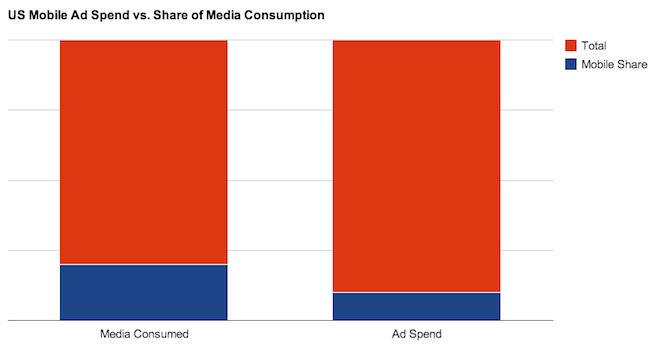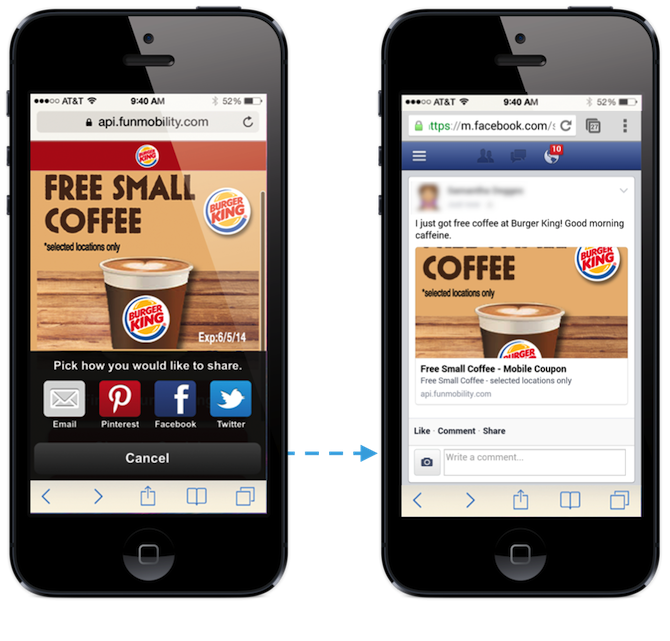Mobile ads can seem daunting, in the beginning. Getting your first successful campaign off the ground means educating yourself about a number of different technologies, best practices, and a frustratingly complex industry ecosystem. Depending on the scope of your ambition, it can also mean making a huge financial investment into a media channel you know very little about.
But before you let yourself get too intimidated by the prospect of mobile ads, it’s important to remember a few things:
Mobile Ads Enable 1-to-1 Marketing
Modern consumers are intimately connected to their mobile devices—at home, at the office, at the mall—everywhere they go, every hour of the day. For the first time in history, marketers and advertisers have the opportunity to engage individual consumers, in any context imaginable. Mobile devices are the first truly personal 1-to-1 marketing channel. Families sit around televisions, people share desktop computers, and nobody reads the newspaper anymore. But mobile devices are personal—one person for one device.
Meaning mobile ads can be targeted to specific individuals, so you only pay for ad impressions with the most relevant consumers.
Mobile Ads Offer More Attention, With Less Competition
Mobile ad spend is still extremely disproportionately low in relation to mobile’s share of consumer attention. According to Business Insider, mobile devices account for more than 20% of ALL media consumed, across all channels–yet mobile’s share of overall ad spend is still less than 10%. This means fewer advertising dollars are being spent to compete in a media channel getting more consumer focus.
In other words, mobile ads see more attention, with less competition.

Mobile accounts for 20% of all media consumed, but mobile ads account for less than 10% of media spend.
But these conditions won’t last forever. Mobile ad spend is projected to keep growing at an explosive rate, reaching $100 billion annually by 2017—meaning the longer you wait to get started with mobile ads, the more competitive the market will get. For advertisers who wait too long, it will be that much harder to break into this new market.
5 Steps to Getting Started With Mobile Ads
FunMobility’s Mobile Advertising Platform is designed to make getting started with mobile ads as intuitive as possible by streamlining every step of the process. But regardless of the specific vendors and technologies you ultimately choose to go with, the basic process of getting your first mobile ads in flight will involve the same 5 steps:
-
1. Define Your Audience
2. Design Your Ad
3. Define Your Goal
4. Choose a Mobile Ad Network
5. Track and Measure Everything
(note: for simplicity’s sake, this post will focus only on creating mobile display ads. Paid mobile search ads will be discussed in a future post.)
1. Define Your Audience
More than any other marketing channel, mobile allows advertisers to target their ideal audience. The best mobile advertising networks include deep targeting options, allowing you to segment your audience by demographic (age, gender, etc), interest (what type of sites and apps are they likely to use), time of day, and location (because of mobile’s status as an on-the-go device, consumers can be targeted by a precisely defined geographic region).
So, before you even get started with creating your ad, make sure to define exactly who your perfect customer is. Highly-targeted campaigns are more expensive, but they are also much more likely to generate a better return on investment by making sure your mobile ads are only seen by the most relevant consumers. Create a consumer persona with a defined:
-
Gender
Age
Interests (Sports, News, Parenting, Entertainment, etc)
Time of Day (When do you want your ads to run?)
Geographic Area (Exactly where do you want your ads to run? Note that mobile geo-targeting allows you to focus either on pre-set regions like zip codes, or on custom-defined areas)
2. Design Your Display Ad
By far the most common type of mobile display ad is the 320×50 banner ad. On a mobile device’s smaller screen, these banner ads have to do a lot of work with a tiny piece of real estate. I already covered best practices for mobile banner ad design in an earlier post, but the basic considerations are:
-
Clear call to action
High contrast colors
Minimal Text & Imagery
File Size of 10K-40K
Cohesive Post-Click Experience
It is also highly recommended that your mobile ads employ rich media (animation, video, interactivity), as opposed to old-fashioned static media. Across the industry, reports cite the performance of rich media mobile ads as being several times higher.
3. Define Your Goal(s)
There are some long-standing prejudices against mobile ads in terms of overall functionality. Even major brands with huge advertising budgets often handicap their mobile ads by having the post-click experience re-direct consumers away from the content they were browsing—to an entirely different mobile website or landing page.
But the actual potential of mobile ads is much more diverse, and your campaign can be customized to accomplish any number of marketing and advertising goals, incorporating a variety of interactive post-click experiences within the ad units themselves. When a consumer clicks on your banner ad, it doesn’t need to take them to a different website—now the ad itself can be triggered to expand as an interactive overlay and deliver rich experiences right then and there.

Your mobile ads can be specifically tailored to drive social share right from the ad unit itself
So, before you even begin constructing an ad, it’s best to take the time to define the primary goal or goals you would like that ad to accomplish. Though it varies somewhat from industry to industry, the most popular goals for mobile ads are:
-
Tap-To-Call
Store Finder (Generate map directions to participating locations)
Consumer Data Capture
Registrations
Brand Awareness, Promotion Awareness
App Download & Install
4. Choose The Right Mobile Ad Network
In an earlier post, I compared and contrasted the value of premium mobile ad networks vs. blind mobile ad networks. There are a number of different mobile ad networks out there that serve clients of all sizes, but whichever mobile ad network you ultimately do decide to go with, your primary concerns should be transparency and reach.
There are a number of different pricing models available to advertisers, depending on the type of network they choose and the specific publishers involved (publishers refer to the sites and apps where your ad will actually appear):
-
CPM (Cost Per Mille) – The advertiser pays a set amount for every thousand ads served. This means that you will be charged for every ad that loads on a consumer’s mobile device, regardless of whether or not the consumer clicks or interacts with it in any way.
CPC (Cost Per Click) – The advertiser pays only for consumers who actually infer interest by clicking on the mobile display ad. Because this pricing model involves less risk than CPM, it is usually reserved for lower-profile publishers.
CPA (Cost Per Action)/CPI (Cost Per Install) – The advertiser pays only for a specific action taken by consumers, most commonly downloading a mobile app from the app store. This model has very little risk for advertisers, and as a result is less freely available amongst top-level publishers.
5. Track and Measure Everything
Not all reporting software is created equal, and not all vendors offer comprehensive analytics measuring every aspect of every campaign. There’s a reason that 75% of marketers and advertisers cite performance tracking as their #1 concern—it’s the only way to tell if what you’re doing is even working, and the only way to improve future campaigns.
A good reporting suite for your mobile ads also offers in-depth audience insights, so you can make sure the ideal consumers you are targeting with your campaigns are engaging with the mobile ads in the way you want.
For a more comprehensive view of how mobile ads work, these free eBooks and whitepapers are a great place to start:
Mobile Advertising Trends Report 2014
8 Secrets to Mobile Advertising Success

